The Ethereum ecosystem is on the verge of experiencing advanced security features and transaction functionality through the emergence of smart contract wallets and account abstraction. However, the adoption of this technology is still progressing slowly. During ETHGlobal in London, Cointelegraph interviewed Lukas Schor, co-founder of Safe, to explore the potential of smart contract accounts and account abstraction in unlocking Ethereum’s full potential.
Schor referred to a recent blog post by Vitalik Buterin, which outlined three transitions that need to occur in Ethereum, one of them being the shift to smart accounts. Safe, originally developed as an in-house multisignature wallet by Gnosis, was created to manage a substantial amount of Ether raised during its initial coin offering. As there were no battle-tested multisignature wallets available at the time, Gnosis founder Stefan George decided to build his own and open-sourced it. This wallet soon became the standard for multisignature wallets in the Ethereum community.
Thus, Gnosis Safe was born and eventually became a standalone offering known as Safe. It now serves as the smart account infrastructure for Ethereum users, layer-2 solutions like Optimism and Polygon, and exchanges like Bitfinex. Safe currently secures over $100 billion in value across more than 7.5 million smart account addresses.
Smart accounts address security and user experience challenges within the Ethereum ecosystem. They offer new design spaces to solve long-standing UX and security issues, such as cross-chain interoperability and key management. Smart accounts allow for batch transactions, making DApp interactions more seamless by bundling multiple on-chain actions into a single transaction. They also provide security guarantees through multisig functionality and key rotation, allowing users to change signing keys without migrating assets to a new account.
Furthermore, smart accounts enable the automation of traditional finance concepts like subscriptions and offer on-chain security features such as allow and deny lists to block interactions with malicious contracts. They can also reduce friction for non-Web3 users by allowing them to onboard using Web2 social accounts or email addresses, with the option to transition to a more trustless setup later.
Schor believes that the adoption of smart accounts will follow a “first slowly, then all at once” trajectory. He acknowledges that most users still utilize externally owned accounts (EOA) through wallets like MetaMask, which is why many applications and wallets cater to this user base. However, layer-2 protocols have the opportunity to start fresh, and the proposed migration EIP-7377 could expedite adoption by eliminating the need to optimize for legacy users.
Safe has focused on specific user groups that would benefit the most from the additional security and flexibility of smart accounts, including Ethereum ecosystem teams and DAOs. Over time, adoption has gradually expanded to less technical and lower-value use cases, as evidenced by Worldcoin’s deployment of six million smart accounts. Schor believes that 2024 could be a breakout year for smart accounts, with catalysts such as Coinbase leveraging them, the development of cross-chain smart accounts, and the implementation of EIP-7377 driving migration.
In conclusion, the emergence of smart contract wallets and account abstraction brings advanced security features and transaction functionality to the Ethereum ecosystem. While adoption is currently progressing slowly, the potential of smart accounts to enhance security and user experience is significant. With the right catalysts and the support of layer-2 protocols, the adoption of smart accounts could accelerate, leading to widespread implementation in the future.

